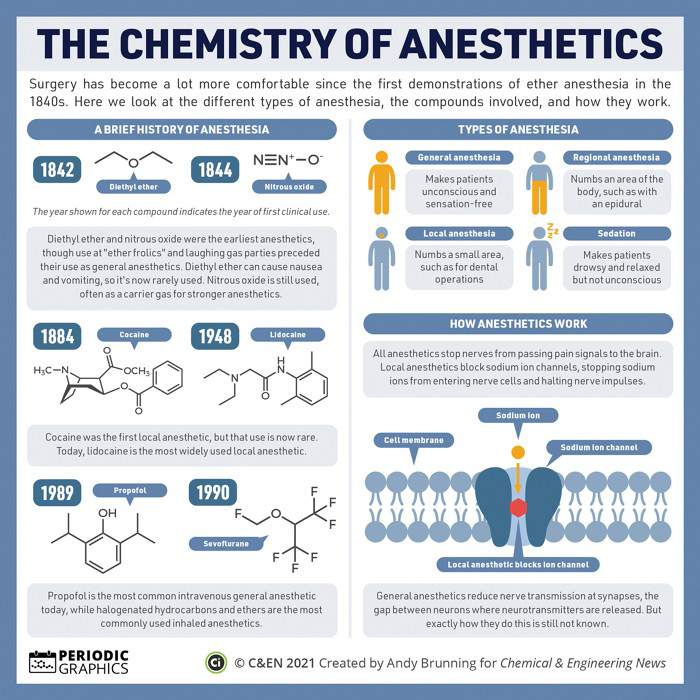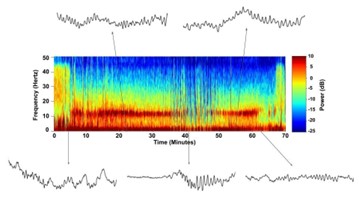If you’ve ever had a surgery or even a minor procedure, you’ve probably benefited from the medical marvel of anesthesia—the treatment that doctors, called anesthesiologists, give to keep you from feeling pain. And it’s come a long way since the discovery of diethyl ether. Here we dive into the different types, its history, and the way it works.
 The chemistry of anesthetics has advanced since the 1840s, producing different types of anesthesia depending on the compounds involved. See more chemistry infographics like this one in C&EN’s Periodic Graphics collection. Click to enlarge.
The chemistry of anesthetics has advanced since the 1840s, producing different types of anesthesia depending on the compounds involved. See more chemistry infographics like this one in C&EN’s Periodic Graphics collection. Click to enlarge.
Types of Anesthesia
Anesthetics—drugs that cause anesthesia—are divided into four categories based on the level and intensity of their effects:
- Sedatives relax the patient and make them drowsy but don’t cause them to lose consciousness.
- Local anesthetics, as the name implies, only numb a small, local area of the body. They’re useful for dental operations or other localized procedures.
- Regional anesthetics numb a larger area of the body. Epidurals are common regional anesthetics, numbing a patient from the waist down.
- General anesthetics are the most intense type, causing the patient to become unconscious and lose all sensation.
The History of Anesthesia
In the early 1840s, doctors first anesthetized patients by having them breathe in the gases of diethyl ether. It was used during surgeries despite its side effects of nausea and vomiting afterward—which you would imagine is preferable to having a surgery or medical procedure when you’re awake and can feel the pain!

Soon after that, nitrous oxide became an option for doctors. It’s still used today but usually just as a carrier for stronger inhaled anesthetics. Some of these stronger drugs are ethers, similar to diethyl ether. But scientists have tweaked their chemistry to reduce toxic side effects, as seen in sevoflurane, which was introduced in 1990 and is still commonly used. Today, anesthesiologists can also deliver anesthetics intravenously, or into a vein through a needle, and propofol is the most common one used in this way.
The first local anesthetic that doctors used in patients was cocaine, but it’s rarely used today due to its addictive properties. Lidocaine, introduced in 1948, is now the most commonly used local anesthetic.
How Anesthesia Works

Anesthesia prevents the feeling of pain by keeping nerves from passing pain signals to the brain. Local anesthetics do this by blocking sodium channel proteins. These proteins pass sodium ions through cell membranes to transmit signals, and when anesthetics block them, the ions can’t enter the nerve cells and the signals are stopped. General anesthetics work at synapses, the gap between nerve cells where neurotransmitters—the chemical messengers that pass signals between nerve cells—are released. But scientists still don’t know the exact method of how general anesthetics reduce transmission at these synapses.
NIGMS-Funded Anesthesia Research
Many scientists supported by NIGMS study anesthesia. Some of these researchers are:
- Investigating how general anesthetics cause unconsciousness, which could lead to new ways to determine consciousness in patients undergoing general anesthesia and those with consciousness disorders
- Examining how anesthetics bind to specific receptors to provide insight into how new drugs that block them—anesthetic antagonists—could be developed
- Exploring how general anesthesia triggers a life-threatening condition called malignant hyperthermia in people with a specific genetic variant
- Understanding how cells from different parts of the brain respond to anesthesia, which could lead to new ways to help patients recover from anesthesia and new anesthetics with fewer side effects
Learn about other scientific terms with the NIGMS glossary.

This post is a great supplement to Pathways: The Anesthesia Issue.
Both this post and Pathways discuss anesthesia.
Learn more in our Educator’s Corner.


